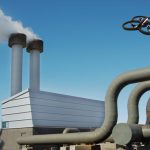 Whilst consumer drones have garnered the majority of the media attention in recent years, in terms of their commercial application, they have primarily been used by utility companies to allow for monitoring of remote and disparate installations.
Whilst consumer drones have garnered the majority of the media attention in recent years, in terms of their commercial application, they have primarily been used by utility companies to allow for monitoring of remote and disparate installations.
For instance, Sharper Shape work with utilities to allow inspections to be carried out remotely, whilst Pro Drone provide similar services for the inspection of wind farms. Drones have even been used to monitor fracking sites for the gas emitted.
A team from the University of Aberdeen propose they can also be used to monitor oil and gas pipelines. In a recently published paper, the researchers explain how drones could be used to conduct the regular inspection and monitoring required.
At the moment, such monitoring is usually conducted either on foot or by helicopter, so drones could provide significant efficiency savings, especially in remote areas.
“The main risk posed by an oil or gas pipeline is the existence of a spill or a leakage that threatens to cause an environmental disaster, not to mention the risk of an explosion,” the authors say. “A thorough system for pipeline monitoring requires the use of specific sensors that can detect rust or corrosion – or if the pipeline is beneath the ground, the existence of methane or changes in the surrounding vegetation that indicate a failure.”
Drone based monitoring is increasingly viable because sensor technology is advancing at a sufficient pace to allow small, yet powerful sensors to be fitted to the drone. The paper outlines a number of possible use cases for drones in the energy sector, from the deployment of small multirotor platforms in local inspection missions, to the use of fixed wing devices better suited to covering large areas, especially linear routes.
“One of the main benefits of using drones for this analysis is that they can be programmed to cover large areas in a systematic way, as well as get to difficult to reach areas,” the paper says. “Not only would this be more cost-effective, but it allows inspectors a flexible solution to any issues of restricted access, which may prove crucial in identifying a problem.”
Such use cases may lack the glamor or public attention of urban delivery drones, but they look set to lead the way in the widespread deployment of the technology. The authors contend that the use of drones for inspection, monitoring and maintenance of oil and gas pipelines will be coming sooner rather than later.